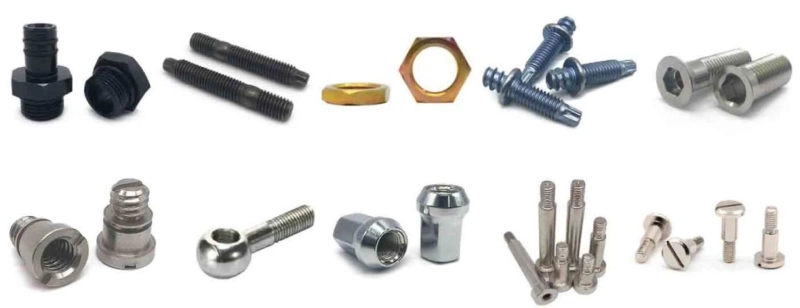Bolt is a mechanical part, which is equipped with a cylindrical threaded fastener of a nut. A type of fastener consisting of a head and screw (cylinder with external thread) shall be matched with the nut to fasten and connect two parts with a through-hole. This type of connection is called the bolt connection. If the nut is unscrewed from the bolt, the two parts can be separated, so the bolted connection is removable.
The types of bolts can be divided into ordinary ones and those with reamed holes according to the stress mode of connection. According to the shape of the head: hexagonal, round, square, countersunk, and so on. The hexagon head is the most commonly used one. Generally, a countersunk head is used where a connection is required.
The name of the riding bolt is U-bolt, which is a non-standard part, and its shape is U-shaped, so it is also called U-bolt. The two ends have threads that can be combined with the nuts. It is mainly used to fix tubular objects such as water pipes or sheet objects such as the leaf springs of cars. Because the way of fixing objects is like people riding on horses, it is called riding bolts. It is divided into full thread and nonfull thread according to thread length.
The thread is divided into coarse thread and fine thread according to the thread type. The coarse thread type is not shown in the bolt mark. Bolts are divided into eight grades according to their performance grades: 3.6, 4.8, 5.6, 6.8, 8.8, 9.8, 10.9, and 12.9. Bolts above grade 8.8 (including grade 8.8) are made of low carbon alloy steel or medium carbon steel and heat treated (quenched+tempered). They are generally called high-strength bolts, and bolts below grade 8.8 (excluding grade 8.8) are generally called ordinary bolts.
Ordinary bolts can be divided into three grades: A, B, and C according to the manufacturing accuracy. Grade A and B are refined bolts, and Grade C is rough bolts. For connecting bolts used for steel structures, unless otherwise specified, they are generally ordinary rough C-grade bolts. The processing methods of different grades are different, and the corresponding processing methods are usually as follows: 1. The bolt rods of Grade A and B bolts are processed by lathes, with smooth surfaces and accurate dimensions. The material performance grade is 8.8. The production and installation are complex, and the price is high, so they are rarely used; 2. Grade C bolts are made of unprocessed round steel, and the size is not accurate enough. The material performance grade is 4.6 or 4.8. The shear connection is characterized by large deformation, convenient installation, and low production cost. It is mainly used for tensile connection or temporary fixation during installation.
Bolts play an important role in industry, so bolt manufacturers often need to pay more attention to the quality and inspection of bolts.
Bolt inspection is divided into manual inspection and machine inspection. Manual is the most original and widely used consistency detection method. To reduce the outflow of defective products as much as possible, the general production enterprise personnel inspect the packaged or shipped products by visual means to eliminate defective products (including tooth injuries, mixed materials, rust, etc.).
The other is fully automatic inspection, mainly magnetic particle inspection. Magnetic particle flaw detection is to use the interaction between the magnetic leakage field at the bolt defect and the magnetic powder. Because of the difference between the magnetic permeability of the possible defects (such as cracks, slag inclusions, mixtures, etc, The position and shape of defects are revealed, and the accumulation of these magnetic particles is observed and explained to eliminate defective products.
Bolts are indispensable in daily life and industrial production and manufacturing. Bolts are also known as the rice of industry. It can be seen that bolts are widely used. The application scope of bolts includes electronic products, mechanical products, digital products, electrical equipment, and mechanical and electrical products. Bolts can also be used in ships, vehicles, water conservancy projects, and even chemical experiments. Anyway, bolts can be used in many places. Such as precision bolts used on digital products. DVD, micro bolts for cameras, glasses, clocks, electronics, etc; General bolts for TV, electrical products, musical instruments, furniture, etc; Large bolts and nuts are used for projects, buildings, and bridges; Transportation appliances, aircraft, trams, automobiles, etc. are used with large and small bolts.
Generally, the countersunk head is used where the surface is smooth without protrusion after connection, because the countersunk head can be screwed into the part. Roundheads can also be screwed into parts. The tightening force of the square head can be larger, but the size is large. In addition, to meet the needs of locking after installation, if there are holes in the head and the rod, these holes can prevent the bolts from loosening when they are subjected to vibration.
The polished rod without the thread of some bolts should be made thin, which is called a thin waist bolt. This kind of bolt is favorable for connection under variable force. There are special high-strength bolts on the steel structure, the head will be larger, and the size will also change. In addition, there are special uses: T-shaped slot bolts are used, and most of them are used on machine tool clamps. The shape is special, and both sides of the head should be cut off. The anchor bolts, which are used to connect and fix the machine and the ground, have many shapes. U-bolt, as previously described. wait. There are also special studs for welding. One end has a thread and the other end has no thread. They can be welded to the parts, and the other side directly screws the nuts.
0


